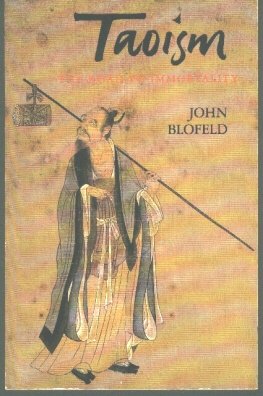
1978
Anson, Jay, AMITYVILLE HORROR, THE, 2, 1978, Bantam, PB. See also 1979 movie title. The Amityville haunting says a lot about the way popular non-fiction is written these days. It was a deal. The Lutz's and the lawyer for the late DeFeo family, William Weber, "sold" the story to Prentice Hall. The publisher then contracted Jay Anson to write their story for them. Anson was very ill at the time, and wrote in his sickbed, from audio tapes provided. Most of his investigating was done by telephone. He never visited the house in the flesh.. There were a lot of factual errors (like what the weather was like on a given day, etc.). Anion is dead now, so is's hard to know if it is just artistic license or not. A close reading will reveal a lot of ambiguous wording that authors sometimes use to distance themselves from the material. At best, the events surrounding the Long Island house seemed to be an orchestrated "media event" (see movie entry 1979).
Anthony, Piers (Piers A. D. Jacob), CHAINING THE LADY, 1978, Avon, PB. 2nd novel in the CLUSTER series. See Introduction.
Anthony, Piers (Piers A. D. Jacob), KIRLIAN QUEST, 1978, Avon, PB. 3rd novel in the CLUSTER series. See Introduction.
Asprin, Robert, ANOTHER FINE MYTH, 1, 1978, Donning Co., Trade. Illustrations by Kelly Freas. See 1979 entry. I first read about this title in Isaac Bonewitz's new edition of REAL MAGIC (1979 entry). He wrote that it was "a profound introduction to the higher subtleties of magical theory and practice--and a hysterically funny novel." Such praise from the merry prankster of ritual magic could have doomed this book to obscurity, but it survived nicely. After two mass paperback editions, the comic book, the graphic novels and the games, can the movie and the television series be far behind? Asprin was a not-too-successful science fiction writer when he wrote this. It was not the occult underground which made this book a success. It was the fantasy game crowd and the readers of light generic fantasy novels who made it into a true cult phenomenon.
Bailey, Lloyd R., WHERE IS NOAH'S ARK, 1978, Abington (Nashville, TN), PB.
Berger, Thomas, ARTHUR REX, 1, 1978, Delacorte, HB. entry
BEYOND AND BACK, Motion Picture, 1978. Sunn Classic "documentary"
about near death experiences.
 |
Blofield, John, TAOISM, 1978, 1, Shambhala, Trade. Reprint of 1978 British ed. |
Bowles, Norma, and Hynds, Fran, PSI SEARCH: THE COMPREHENSIVE GUIDE TO PSYCHIC PHENOMENA, 1978, Harper and Row, HB. Need Copy and Info.
Bronowski, Jacob, MAGIC, SCIENCE AND CIVILIZATION, 1978, Columbia University Press, HB.
Brown, Peter Lancaster, MEGALITHS, MYTHS, AND MEN, 2, 1978, Harper and Row, Trade. This is a well-written general survey of astroarchaeology by an astronomer. Brown represents a solid middle-of-the-road approach in a field with wildly conflicting opinions. Brown was a busy writer who essentially rewrote this material again as MEGALITHS AND MASTERMINDS (1979).
Brown, Barbara B., STRESS AND THE ART OF BIOFEEDBACK, 2, 1978, Bantam, PB.
CAPRICORN ONE, Motion Picture, 1978, , Writer/Director: Peter Hyams, During the 70's, science writer and UFOlogist Otto Binder (see 1967 entry), and other radio buffs, were claiming that some very strange things were going on during the Apollo flights, and NASA was covering it up. Some of this may have inspired CAPRICORN ONE. The film concerns a faked Mars mission. A NASA contractor delivers a faulty life support system, and NASA fakes the mission rather than call it off at the last minute. The astronauts go along with the hoax. When an unforseen accident destroys the unmanned capsule in space, they realize that they're going to be killed, and run for it. The movie took a lot of critical flak for suggesting that NASA would engage in such incompetence. Now, Hal Holbrook's little speech about how everything went wrong has a prophetic sound. The climax of the film is one of the best aerial chases ever performed (see Watkins, ALTERNATIVE 3, 1978 and 1979 entries).
Carpenter, Humphrey, INKLINGS, THE, 1, 1978, Houghton Mifflin, HB. Carpenter is the official biographer of J. R. R. Tolkien, author of TOLKIEN: A BIOGRAPHY. This examines a literary circle that centered around Tolkien, C. S. Lewis, and Charles Williams. These personalities were to have profound effects on the popular literature in the post-War world. All this is more fascinating when you realize that all three were swimming upstream in the Modernist literary world. Lewis was more at home with medieval romances, and loathed the literature of his time. Tolkien's taste ran to Victorian adventure novels. Williams' tastes were in the neo-romanticism/ symbolist camp. From them we get the theological novel (Lewis), the fantasy epic (Tolkien), and the metaphysical novel (Williams). It is an essential book to help understand the origins of 60's and 70's literary trends.
Carpozi, George, Jr., SUICIDE CULTS, THE, 1978, Manor Books, PB. This book is important because it is so deeply ugly and mean spirited. Carpozi is a writer who specializes in quickie nonfiction books, nearly all showing a decidedly knee-jerk right-wing tilt. It's an "instant" paperback on Jim Jones and the Guyana tragedy. According to Carpozi, it was a commie plot. Here's his dedication of the book: "This book is hereby dedicated to the traitors in the U.S. Embassy in Guyana, who helped make this story possible." You get the drift! The book also seems to be an excuse for a long attack on Mark Lane (see 1966 and 1967 entries). What is disturbing about this book is the knowledge that there must have been a sizable market for it. The work is really an alibi for the religious right, who wanted the public to focus on Jim Jones' pseudo-Marxism rather than on his Fundamentalist and Pentecostal roots. (See also Krause, 1978 entry; also Kildruf and Javers, 1978 entry).
CASE FOR ANCIENT ASTRONAUTS, T. V. Documentary, 1978, BBC TV, Broadcast in US on NOVA (PBS), 8 Nov. 1978. The bulk of this program was a spirited refutation of Erich von Daniken's ancient astronaut books, and in this, it was devastatingly successful. Then, almost as an afterthought, the producers decided to add a refutation of "pyramidology," and of Temple's THE SIRIUS MYSTERY (1976 entry) to the end of the show. These final minutes of the program should have been dealt with in more detail on another show, or dropped from it. As it is the bulk of the program shows the skeptical viewpoint at its best, while the remaining minutes show it at its worst.
Cavendish, Richard, KING ARTHUR AND THE GRAIL, 1, 1978, Taplinger, HB. entry
Condon, Richard, WHISPER OF THE AXE, THE, 2, 1978, Ballantine, PB. This
may be the most paranoid of all of Condon's fictional experiments in "creative
paranoia." Condon has a unnerving habit of producing fictional scenarios
which precede actual events. Life imitating art, and all that.
This one has a President of the USA involved in the drug trade (Too
fantastic to be believed, right?). This may be the ultimate in "post-Watergate"
cynicism. Events have been slowly catching up with Condon, who wrote
the first "post-Watergate" novel in 1959 (See ANCHURIAN CANDIDATE).
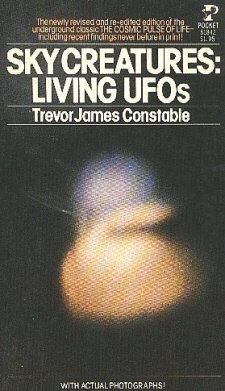 |
Constable, Trevor James, SKY PEOPLE, 2, 1978, Pocket Books, PB. Rewritten ed. of COSMIC PULSE OF LIFE, 1976 entry. True crankishness is relatively rare even in "fringe" literature. Most UFO writers like to stay within the relative ballpark of possibilities. Constable is a refreshing exception to this trend. His theoretical base is the Orgone energy theory of Wilhelm Reich, and the mystical writings of Rudolph Steiner. When Constable goes out to photograph UFOs, he aims at the same section of sky that his Orgone energy "cloudbuster" is pointing, while using film and filters specially designed to conform to Steiner's complex color theories. It is as though one is reading a book written by one of the most outrageous characters from novels by Thomas Pynchon or Robert Anton Wilson. Each page delivers new cranky absurdities piled one upon the others, until the mind actually begins a metamorphosis of consciousness. In other words, this is prime grade, triple-A rated, crank literature, nd not to be missed. |
David-Neel, Alexandra, BUDDHISM: ITS DOCTRINES AND ITS METHODS, 1, 1978, St. Martin's Press, HB. Reprint of 1939 British ed.
Dibdin, Michael, LAST SHERLOCK HOLMES STORY, THE, 1, 1978, Pantheon Books, HB. See 1979 entry.
Ebon, Martin, ed., SIGNET HANDBOOK OF PARAPSYCHOLOGY, THE, 1978, Signet, PB.
Epstein, Perle, KABBALAH: THE WAY OF THE JEWISH MYSTIC, 1, 1978, Doubleday, HB. Trade?
Fell, Barry, AMERICA B.C.: AMERICAN SETTLERS IN THE NEW WORLD, 2, 1978, Simon and Schuster, Trade. Fell's book was hailed by many as a breakthrough for those of us who believe that America was discovered by other groups of Old World peoples, before Columbus. Fell was a biologist from Harvard and author of at least one standard text on environmental biology. His basic scenario for the pre-Columbian voyages is still one of the best thought out historical arguments in Neo-diffusionism. Unfortunately, his evidence was not as convincing as his historical arguments. His New Hampshire Beltain calendar stone, which Fell felt was inscribed in Celtic Ogham letters, turned out to be a natural geological occurrence (see Cazeau and Scott, 1979 entry). Fell's book rekindled interest in the possibilities of Pre-Columbian voyages to America, a subject which still needs more attention (see SAGA AMERICA, 1980 entry).
FM, Motion Picture, 1978, Alonzo, Director: John A., Comic film about an AOR format FM radio station trying to maintain some sort of programming integrity in the face of increasingly commercial pressures. Like SEMI-TOUGH (1977 entry), this film is an excellent "cultural artifact" of the late 70's. The sound track is like a time machine, in itself. This is one of the first films, that I remember, that dealt with the theme of aging 60's types trying to cope with their new middle age status. There seems to be little doubt that this film inspired the television series WKRP IN CINCINNATI, which appeared later in that same year (BUT, WKRP turned FM on its head; WKRP was about a station manager who wanted to go "top 40," while FM is about a station manager trying to resist the move to "top 40" format. (Does television often turn values all round like that?).
Foster, Robert, COMPLETE GUIDE TO MIDDLE EARTH, 3, 1978, Ballantine, PB. Revised ed. of GUIDE TO MIDDLE EARTH, 1971 and 1974 entries.
Fowles, John, MAGUS, THE, 3, 1978, Little Brown, HB. Fowles fine- tuned his famous first novel a little for the 70's. Mostly, he restored several scenes that were considered a little too sexy for 1965. The new edition contains a preface from Fowles that clarifies much of what he had in mind in those days. Has any quick-witted critic (is that a non sequitur?) thought of comparing THE MAGUS with Hesse's STEPPENWOLF? It seems a natural to me!
Fuller, Elizabeth, MY SEARCH FOR THE GHOST OF FLIGHT 401, 1978, Berkley, PB. See Fuller, THE GHOST OF FLIGHT 401, entry below.
Fuller, John G., GHOST OF FLIGHT 401, THE, 2, 1978, Berkley, PB. Entry
Furneaux, Rupert, ANCIENT MYSTERIES, 2, 1978, Ballantine, PB. entry
Gardner, John, REVENGE OF MORIARTY, 2, 1978, Berkley, PB. Moriarty plots his final revenge against Holmes in this second novel about the "Napoleon of Crime" by Gardner. I personally would prefer to see more of these finely written novels and less of Gardner's "new" James Bond novels.
Ginsburgh, Irwin, FIRST MAN, THEN ADAM. 2, 1978, Pocket Books, PB. entry
Gittelson, Bernard, BIORHYTHM, 3, 1978, Warner Books, PB. Revised ed. of 1977 ed.
Gonzalez-Wippler, Migene, COMPLETE BOOK OF SPELLS, CEREMONIES, AND MAGIC, 1, 1978, Crown, HB. See 1988 entry.
Goodavage, Joseph F., OUR THREATENED PLANET, 1, 1978, Simon and Schuster, HB. See 1980 entry.
Goodavage, Joseph, SEVEN BY SEVEN, 1978, Signet, PB.
Goodman, Jeffrey, PSYCHIC ARCHAEOLOGY, 1978, Berkley, PB. This
is a good companion to Schwartz's more mainstream approach (see SECRET
VAULTS OF TIME, 1978 entry). The first half covers much the
same material as in Schwartz's work, but the second half concerns the use
of psychic techniques on several archaeological digs in American Southwest.
I get a little nervous when guys like Goodman take Edgar Cayce and
the "Akashic records" too seriously.
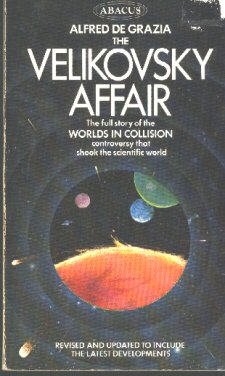 |
Grazia, Alfred de, ed., VELIKOVSKY AFFAIR, THE, 2, 1978, Sphere Books/British ed., PB. Revised ed. See Research Bibliography. |
Gribbin, John R., ed., CLIMATIC CHANGE, 1978, Cambridge University Press, HB. See also FUTURE WEATHER, 1982 entry.
Haggard, H. Rider, WISDOM'S DAUGHTER, 1978, Ballantine, PB. Reprint of 1922 title.
Haggard, H. Rider, ERIC BRIGHTEYES, 1978, Zebra Books, PB. Reprint of 1889 Title.
Haggard, H. Rider, SHE AND ALLAN, 1978, Ballantine, PB. Reprint of 19-- title.
Haggard, H. Rider, MORNING STAR, 1978, Zebra Books, PB. Reprint of 19-- title.
Harris, Marvin, CANNIBALS AND KINGS, 2, 1978, Vintage, PB. See also 1977 entry. 1978 was Harris' year. The shocking argument of the title is: the Aztecs ate their neighbors in religious rituals of blood sacrifice, in order to supplement their deficiency of animal protein. This was caused by earlier over hunting of meat animals in the Mexican basin region. In another equally shocking essay, Harris conjectures that the high rate of infanticide in medieval Europe was also due to a lack of protein. It had been thought that charges of cannibalism were just part of the Spanish rationale for their own barbarism. He did convince me that the Aztecs ate their neighbors, but I didn't buy the "protein determinism," which seems to negate cultural diversity (and blind luck) in determining such things. This is Harris' best book to date.
Harris, Marvin, COWS, PIGS, WARS AND WITCHES, 2, 1978, Vintage, PB. See 1974 entry. This contains Harris' famous essay about why the cow is sacred in India, and why pigs are unclean in the Mid-East. But in further essays, he shows a curious lack of understanding for man's need for spirituality. Harris advances an idea similar to Marx's assertion that "mysticism is the opiate of the masses." He maintains that the monied or aristocratic classes have always used cult beliefs to blunt and defuse positive political and economic activism. There seems no more evidence to support this idea now, than when Marx proposed the mysticism/ activism polarity in the last century. There is ample evidence from all over the world that the opposite is true. This theme runs through all of Harris' books. Be it cults or organized churches, man's religious impulse really irks Harris. Maybe it's because "cultural materialism" is irrelevant to such impulses.
Henderson, David, JIMI HENDRIX: VOODOO CHILD OF THE AQUARIAN AGE, 1, 1978, Doubleday, HB. See 1981 entry.
Hitching, Francis, EARTH MAGIC, 2, 1978, Pocket Books, PB. This was a popular survey of megalithic man and studies on him. The first part of the work deals with astroarchaeology and archaeological information. Part two deals with things more speculative such as psychic archaeology, "ley" lines, and supernatural phenomena associated with megaliths. It was one of the best surveys to cover both the accepted notions and some of the more unorthodox in one volume. Hitching is also a film maker and has written other books on unconventional scientific topics (see 1979 and 1981 entries).
HOLOCAUST 2000, Motion Picture, 1978, Director: Alberto deMartino, Also released as THE CHOSEN. This Italian/British co-production is a clone of the OMEN (1976 entry). It is interesting because the "Great Beast" in the film is a nuclear reactor, which combines the fundamentalist vision of Armageddon with secular fears of nuclear holocaust. Critics hated this picture, but it's actually no worse than the sequels to the OMEN. The screenwriters seem to have actually read the Book of Revelation, which is something that the screenwriters of the OMEN didn't bother to do.
Holtzer, Hans, POWERS OF THE NEW AGE, THE, 1978, Manor Books, PB.
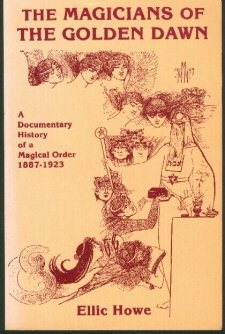 |
Howe, Ellic, MAGICIANS OF THE GOLDEN DAWN, THE, 2, 1978, Samuel Weiser, Trade. |
Humber, Thomas, SACRED SHROUD, THE, 1978, Pocket Books, PB. Revised ed of THE FIFTH GOSPEL, 1974. Need info.
Johnson, Warren, MUDDLING TOWARD FRUGALITY, 1, 1978, Sierra Club (San Francisco, CA), Trade? See 1979 entry.
Kaplan, Stuart R., ENCYCLOPEDIA OF TAROT, THE, 1978, US Games Systems, HB. Stuart is the founder of US Games Systems, the largest publisher (and almost the only publisher) of Tarot decks in the US. Kaplan wrote a whole shelf on the Tarot in the 70's. Most of them were written to accompany decks Kaplan's company sold, and were fairly standard "cookbooks." This volume is an exception. He covers the history and development of the deck, and most of the occult doctrines associated with it. The best thing about this volume is its illustrations showing the designs and variations from medieval to present times. It is fascinating to follow the metamorphosis of the designs as the artists of each age revised and interpreted the symbols to reflect their times. Kaplan also includes one of the most complete bibliographies on the subject available anywhere. (See TAROT CLASSIC, 1972).
Kerouac, Jack, TRISTESSA, 2, 1978, McGraw Hill, Trade.
Kilduff, Marshall, and Javers, Ron, SUICIDE CULT, THE, 1978, Bantam,
PB. A SAN FRANCISCO CHRONICLE Production.
| Koestler, Arthur, THIRTEENTH TRIBE, THE, 2, 1978, Popular Library, PB. Subtitle: THE KHAZAR EMPIRE AND ITS HERITAGE. Koestler presents evidence that the eastern European Jews (Ashkenazim) are really descendants of the Turkic Khazars, a central Asian tribe which converted to Judaism in the 10th century. Koestler took a lot of flak for this (and he's still taking it, in his grave), as though this is some new and insidious idea. It was not! Jewish historians have known and wrote about it for years. Koestler just wrote a popular book about it. Some neo-Nazi groups tried to twist it into some sort of justification (Logic: See, Hitler didn't kill six million Jews, after all. They were Turks. Huh?). The book also caused some turmoil in the Zionist community because there are racial tensions among the Ashkenazim, the Sephardim (people of the Diaspora) and the Sabra (native Palestinian Jews) within the modern Israeli state. The book is a good look at a little known "secret" of history, and deserves a second reading. |
Krause, Charles A., et. al., GUYANA MASSACRE, 1978, Berkley, PB. A WASHINGTON POST Production.
Krupp, E. C., IN SEARCH OF ANCIENT ASTRONOMIES, 1, 1978, Doubleday, HB. See 1979 entry.
Landsburg, Alan, IN SEARCH OF..., 1978, Nelson Doubleday, HB, This is
a book club edition and a condensation of the five IN SEARCH OF...
television books published by Bantam (see 1976 and 1977 entries).
The IN SEARCH OF... titles were already quick summaries in the first place,
making this the "fringe" book for folks in a real rush.
| le Poer Trench, Brinsley (Earl of Clencarty), MYSTERIOUS VISITORS, 2, 1978, Stein and Day, PB. Le Poer Trench is one of the advocates of the "extradimensional" origin of UFOs. Bluntly, they "punch" through dimensional "windows" into our dimension. This may explain why they are able to perform some of their impossible feats. This idea is interesting reading. The author seems to accept the precepts of some of the "saucer theologies." and this title contains a nice summary of its main points. Le Poer Trench's books are fun to read, even if some of the material is a bit tilted. |
Lilly, John C., SCIENTIST, THE, 1, 1978, Lippincott, HB, Also Bantam ed. ?
Lilly, John, COMMUNICATION BETWEEN MAN AND DOLPHIN, 1978, Crown, HB. Need Copy and Info.
Lovecraft, H. P., COLOR OUT OF SPACE, THE, 1978, Jove, PB.
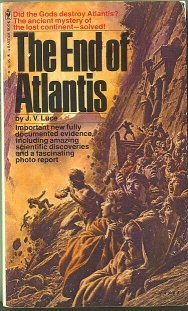 |
Luce, J. V., END OF ATLANTIS, THE, 2, 1978, Bantam, PB. Dispite the sensational cover, this is one of the better books on archaeological theories that the Aegean island of Thera was the model for Atlantis. |
Lunan, Duncan, MYSTERIOUS SIGNALS FROM OUTER SPACE, THE, 2, 1978, Bantam, PB. Reprint of INTERSTELLAR CONTACT, 1975 entry.
Mander, Jerry, FOUR ARGUMENTS FOR THE ELIMINATION OF TELEVISION, 1978, William Morrow, HB. Need Copy and Info.
Margulies, Leo, ed., WORLDS OF WEIRD, 2, 1965, Jove, PB.
Masters, Anthony, DEVIL'S DOMINION, THE, 1978, Putnam, HB. PB? Satanism is one of those topics where real information is scarce. Most books on Satanism are really about witchcraft, ritual magic, or "demonic possession." That is exactly what this one is about. Like many other recent books approaching the subject, it repeats information that was already available. Masters is a fairly reputable author in other fields, but he didn't overtax himself on this title. If you have ever wondered what the average college sophomore term paper would look like if it were 268 pages long, this volume will satisfy your curiosity. By the late 70's, there were a lot of books on the occult that were more or less idistinguishable from one another.
Matthiessen, Peter, SNOW LEOPARD, THE, 1, 1978, Viking, HB. See 1979 entry.
McGregor, Don, and Gulacy, Paul, SABRE, 1, 1978, Eclipse Comics, Trade. Graphic Novel later reprinted in comic format (1982). The founders of Eclipse Comics were militant in their belief that the "authors" of comics, i.e. the writer and artist, should be credited as such. So, I have listed this as though it were any other book. The graphic novel is primarily a European medium, which became more common in the USA in the late 70's. Eclipse often claims to be one of the US innovators of the graphic novel format. This is true only in the most narrow interpretation of the graphic novel as produced inside the comic book publishing world. Grove Press could probably rightfully claim to have innovated the graphic novel in the American book trade (see BARBARELLA, 1965 entry). There is little doubt that when SABRE appeared, that the comic reader was ready for products with more adult themes. Eclipse would grow to be one of a growing number of small comic companies willing to challenge the "big two" (Marvel and DC) US comic publishers.
Monaco, Richard, PARSIVAL: OR A KNIGHT'S TALE, 2, 1978, Pocket Books, PB. entry
Morrison, Tony, PATHWAYS TO THE GODS, 1978, Harper and Row, HB. Incorporating the work of Gerald S. Hawkins This is a personal investigation of the straight paths and lines created by the earlier civilizations of the Andes. Morrison looks into the famous Nazca lines, but also examines the many lesser known tracks. There's a lot of information from Hawkins' (see 1965 entry) studies suggesting that the lines may not be astronomical in origin (something different!). It is nice to read something fairly level headed about a phenomenon associated with speculative fantasies, once in a while.
Muck, Otto, SECRET OF ATLANTIS, THE, 1, 1978, Times Books, HB.
| Nasr, Seyyed Hossein, INTRODUCTION TO ISLAMIC COSMOLOGICAL DOCTRINE, AN, 2, 1978, Shambhala, Trade. |
 |
O'Neill, Gerard K., HIGH FRONTIER, THE, 2, 1978, Bantam, PB. One of the dreams shattered by the Challenger disaster was that of operational space colonies by the turn of the 21st century. In the late 70's, there was great excitement about this possibility. O'Neill was the best known advocate, publicist, and booster for the space colony. To get an idea of how pervasive the dream was just review the first two years of OMNI, which began its run in 1978 (entry). O'Neill's book is both fantastic and visionary in the best sense of the word. Of the many books reviewed for this work, I found reviewing this one filled me with the strongest sense of sadness. This is especially ironic because I was not very interested in space colonies, at the time, nor was I very enthused about O'Neill's book. Even so, lost dreams are sad to relive. |
OMNI, Magazine, 1978, First Issue, October 1978, OMNI completely changed the format and look of science magazines. It was the second publication of PENTHOUSE publisher Bob Guccione. He applied the same style to OMNI--slick, glossy, beautifully photographed, with high quality stories and articles. Omni was also willing to debate fringe scientific ideas, eventually devoting a whole section called "Antimatter" to such topics as UFOs, ESP, and the like. OMNI also helped popularize the concept of the space colony (see O'Neill, 1978 entry). Recently the editors have begun to view the excesses of CSICOP (see 1977 entry) with some alarm. With the demise of the more hard core humanist SCIENCE in 1986, only DISCOVER comes close to OMNI's quality. And it doesn't come too close, either.
Percy, Walker, LOVE IN THE RUINS, 3, 1978, Avon, PB.
Playfair, Guy L. and Hill, Scott, CYCLES OF HEAVEN, 1, 1978, St. Martin's
Press, HB. See 1979 entry.
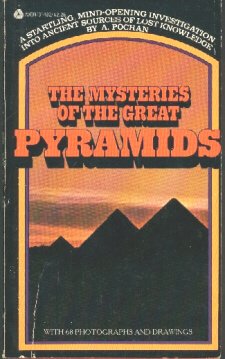 |
Pochan, A. THE MYSTERIES OF THE GREAT PYRAMIDS, 1978, 1, Avon, PB. Rpt of 1971 French ed. |
Ponce, Charles, KABBALAH, 2, 1978, Quest Books, Trade.
PROJECT U.F.O., Television Show, 1978, Jack Webb, Executive Producer:,
First episode 19 Feb. 78; Last episode 30 Aug. 78.
| Rajneesh, Bhagwan Shree, MEDITATION, 1978, Harper and Row, PB. This is a series of lectures by the Tantric Indian guru. It is also his first book to appear in an American commercial edition (though you could get a small library through his foundation). In the next few years Harper and Row would publish over a dozen titles by Rajneesh. At this time, he was attracting a large crowd of Westerners to his Ashram center in Poona, India. When this appeared, it was a breath of fresh air among the profusion of other marblemouthed Indian holy men. Rajneesh was articulate, intelligent, and amazingly blunt--qualities rarely attributed to the guru type. In my opinion, it was his no-nonsense style, not the Tantric/sexual aspects of his teachings, that made him so popular. Indian Tantra had been taught in this country long before Rajneesh arrived in Oregon. |
Ransom, C. J., AGE OF VELIKOVSKY, THE, 1978, Delta, Trade. Ransom was editor of KRONOS, a journal devoted to Velikovsky's idea, and defending them against his many critics. It is as spirited a defense of Velikovsky as one could want. An earlier book, THE VELIKOVSKY AFFAIR (Gazia, 1966 entry) was an anthology of writings by various Velikovsky supporters. This one is a good one to read after reading a heavy diet of Martin Gardner and the "skeptics" from the scientific materialist school. It may surprise the reader, as it surprised me, to find some fairly reputable people willing to defend him. It will also come as a shock to learn that some of the arguments used by some of Velikovsky's critics have been just as misleading as anything they accused him of using. Ransom's book is an essential tool for those trying to discover the middle ground.
Rogo, D. Scott, and Bayless, Raymond, PHONE CALLS FROM THE DEAD, 1978, Prentice Hall, HB. This is one of my candidates for the silly title award. I first saw this title on the stands, and laughed, and laughed, and laughed. No, they are not kidding. This really is about spirits who want to reach out and touch someone. It gives new meaning to the expression "the ghost in the machine."
Rogo, D. Scott, MIND BEYOND THE BODY, 1978, Penguin Books, PB.
Roszak, Theodor, PERSON/PLANET, 1978, Doubleday, HB and Trade?
Saberhagen, Fred, HOLMES--DRACULA FILE, THE, 1978, Ace, PB. This is science fiction writer Saberhagen's early entry into the growing Holmes pastiche market. This one is distinguished by being a double pastiche. First of all, it purports to be a missing episode in the life of Dracula, as well as a famous "missing" Holmes story, "The Giant Rat of Sumatra." Saberhagen, like Wolf (1972 entry) and Rice (1977 entry), sees the vampire as an erotic being, though he also hints that it may be a alien life form, too. He continued his Dracula tales with AN OLD FRIEND OF THE FAMILY (1979 entry) and THE DRACULA TAPES (1985 entry).
Sagan, Carl, DRAGONS OF EDEN, THE, 2, 1978, Ballantine, PB.
Schwartz, Stephen A., SECRET VAULTS OF TIME, THE, 1978, Grosset and Dunlap, HB. PB? This is a well written volume on psychic archaeology (see Goodman, 1978 entry). The historical survey is well done, especially the chapter on Frederick Bligh Bond, the "father" of psychic archaeology. The final chapters concerns theories and methods, and will interest those who want to try it.
Severin, Tim, BRENDAN VOYAGE, THE, 1, 1978, McGraw Hill, HB. See 1979 entry.
Simpson, George E. and Burger, Neal R., THIN AIR, 1978, Dell, PB.
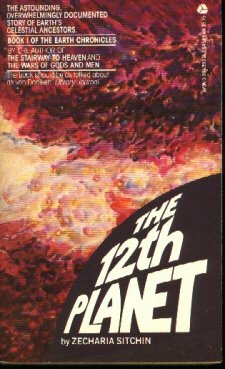 |
Sitchin, Zecharia, 12TH PLANET, THE, 2, 1978, Avon, PB. Sitchin believes that the NEFILIM (Sons of God in GENESIS 6) were an alien race who colonized the Earth in Sumerian times, and who served as the prototypes for Mesopotamian gods. On first glance, Sitchin seems to be a bizarre combination of Velikovsky and von Daniken. The book is actually well researched, and thought provoking, even if the conclusions are far-fetched. His scenario for the planet Modoc and its collision with our solar system are quite similar to recent astronomical speculations about Nemesis (a foreign body which may revisit the solar system once in a blue million years). Sitchin does not claim that these aliens were meddling in our affairs throughout history. He maintains they came during the GENESIS period of the Bible, then they left, and they haven't been back. That is a refreshingly nice touch. The author wrote two more books (1983 and 1985 entries) on this theme that were quite good, and even more after that were largely redundant. |
 |
Speeth, Kathleen Riordan, GURDJIEFF WORK, THE, 2, 1978, Pocket Books, PB. This is an introductory work on G. I. Gurdjieff's complex mystical discipline. What's interesting about it is that it contains more practical information about his methods than was usually published in commercial editions, and it appeared in mass market format. This thin volume remains one of the best, clearly written, books on Gurdjieff that appeared in the 70's. |
St. Clair, David, DAVID ST. CLAIR'S LESSONS IN INSTANT ESP, 1, 1978, Prentice Hall, HB. See 1979 entry.
Strieber, Whitley, WOLFEN, THE, 1, 1978, William Morrow, HB. See 1979 entry.
Tompkins, Peter, SECRETS OF THE GREAT PYRAMIDS, 2, 1978, Harper and Row, Trade.
Trento, Salvatore Michael, SEARCH FOR LOST AMERICA, THE, 1, 1978, Contemporary Books, HB. See 1979 entry.
Valiente, Doreen, WITCHCRAFT FOR TOMORROW, 1978, St. Martin's Press, HB. Need Copy and Info.
Velikovsky, Immanuel, RAMSES II AND HIS TIME, 1978, Doubleday, HB. This is Velikovsky's last volume in the AGES IN CHAOS series, and his final work. In it he continues his attempt to prove that the standard chronology of the Near East is hundreds of years in error (see my comments for PEOPLES OF THE SEA, 1977 entry). It is time for some impartial biographer to examine Velikovsky's life and work. For the record, I think Velikovsky was mistaken in his interpretation of history. I do believe there are some very large inconsistencies in the Mid-East time column that have not been resolved by conventional means. I thank Velikovsky for having pointed out these anomalies, even though I think he erred in his interpretation.
Wambach, Helen, RELIVING PAST LIVES, 1978, Harper and Row, HB. Need Copy and Info.
Watkins, Leslie with Ambrose and, David, Milles, Christopher, ALTERNATIVE 3, 1, 1978, Sphere Books (London), PB. See also 1979 entry. This is surely one of the most paranoid books ever published. The authors maintain that as early as the late 40's, Russia and the US began space travel because they learned that the "greenhouse effect" was eventually going to kill all life on earth. Space colonies were in place by the late 70's. The public space program was just theatre, as space technology is much more advanced than anyone realizes. This international cabal takes only the scientific elite into its confidence, and kidnaps ordinary folk and "alters" them to be their zombie-like slaves on their colonies. Anyone who learns too much about all this, or defects from the program, is microwaved to death so it looks like "spontaneous human ombustion." All of this is based on an investigative program done for a 1977 British ITV science show (but be sure to see 1979 entry).
Wetering, Janwillem van de, EMPTY MIRROR, THE, 2, 1978, Pocket Books,
PB. entry
| White, T. H. White, MERLIN, 1978, 2, Pocket Books, PB. The long lost missing final chapters to THE ONCE AND FUTURE KING. |
Wilcox, Richard K., SHROUD, 2, 1978, Bantam, PB. entry
Wilgas, Neal, ILLUMINOIDS, THE, 1, 1978, Sun Publishing (Albuquerque, NM), ?, See 1979 entry.
Wilkerson, Ralph, BEYOND AND BACK, 1978, Bantam, PB. Tie-in Book for the Sunn Classic film that same year.
Wilson, Robert Anton, COSMIC TRIGGER: THE FINAL SECRET OF THE ILLUMINATI, 2, 1978, Pocket Books, PB. Illustrations by John Thompson. As the subtitle suggests, Wilson does explain some of the ideas that he and Robert Shea used in THE ILLUMINATUS TRILOGY (1975 entry), but the book is really an introduction to Wilson's own personal vision. That vision is both mystical and absurdist. It is surely the most enjoyable introduction to late 70's "new age" subjects. In 1977, it seemed possible that scientific and mystical visions might combine into some new synthesis. No one typifies this ideal better than Wilson. He dances from quantum physics to ritual magic, from space colonies to cosmic consciousness, from Pynchon-style "creative paranoia" to UFO lore, all with a sly quixotic flare (See MASKS OF THE ILLUMINATI, 1981 entry, and SCHROEDINGER'S CAT, 1979 and later entries).
Yarbro, Chelsea Quinn, HOTEL TRANSYLVANIA, 1978, St. Martin's Press, HB.
Yarbro, Chelsea Quinn, PALACE, THE, 1, 1978, St. Martin's Press, HB. 2nd novel in the St. Germain Series.
Yates, Frances A., ROSECRUCIAN ENLIGHTENMENT, THE, 2, 1978, Shambhala,
Trade.
![]() Back to Absolute Elsewhere Contents.
Back to Absolute Elsewhere Contents.